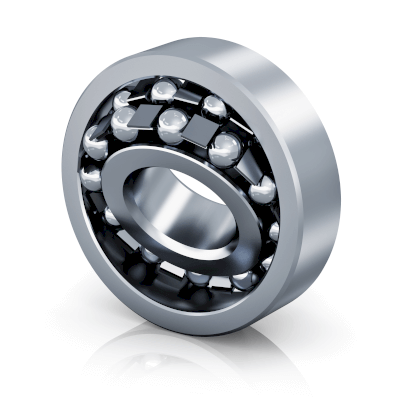What Is a Self-Aligning Ball Bearing?

Self-aligning ball bearings are types of bearings that can rotate even when the shaft’s center is tilted.
These bearings are effective under conditions of large radial loads and when shaft deflection occurs, or when misalignment happens due to the dimensional accuracy of the mounting parts of the bearing components. However, they are not suitable for use where there is a large axial load (load parallel to the shaft).
A bearing, as a mechanical element, minimizes friction in rotating parts of household appliances, cars, and industrial machinery. It supports the smooth operation of the machine and prevents abnormal noise, seizure, and failure caused by friction. It is now one of the indispensable parts because it can keep the shaft in a stable condition without impairing the normal operation of the machine.
Uses of Self-Aligning Ball Bearings
Self-aligning ball bearings are commonly used in woodworking machinery, where shafts tend to deflect or tilt, and in the transmission shafts of spinning machines. The axial load capacity is not that high, so versatility is reduced.
Spherical roller bearings, which are also able to be aligned, use rollers and can support radial and axial loads. They are used in a wide range of fields, including general machinery, rolling mills, and paper manufacturing machinery.
Principles of Self-Aligning Ball Bearings
Various types of bearings exist, which can be roughly divided into rolling bearings and plain bearings. Of these, rolling bearings are used in many types of machinery and equipment, such as cars and industrial equipment. Rolling bearings are mainly composed of the following three elements:
- Raceways (inner and outer rings in which balls and rollers roll)
- Rolling elements (balls or rollers that roll between the inner and outer rings)
- Cage (part that prevents rolling elements from colliding with each other or falling out of the raceways)
The outer ring’s raceway of self-aligning ball bearings features a spherical surface whose center of curvature is aligned with the bearing center. Therefore, the inner ring, rolling elements, and cage can rotate at the same time, even if they are slightly tilted around the bearing center.
Although expertise is required when selecting a bearing, it is important to carefully consider how the load is applied to the shaft and how it is best supported before selecting a bearing that is suitable for the application and purpose.
Types of Self-Aligning Ball Bearings
In addition to the standard open type, there are other types of self-aligning ball bearings, such as sealed and tapered bore types.
1. Self-Aligning Ball Bearings With Seals
Sealed bearings have rubber contact seals on both sides of the balls. This ensures durability even in environments with a lot of dust. Lubrication can also be improved by sealing with grease.
2. Tapered Bore Self-Aligning Ball Bearings
Tapered bore bearings have a tapered bore in the inner ring. By using an adapter when mounting the shaft, the ease of assembly can be improved.
Other Information on Self-Aligning Ball Bearings
Precautions for use
When using self-aligning ball bearings, the following precautions should be taken:
1. There is a limit to the amount of misalignment that can be tolerated.
Even with self-aligning ball bearings, there is a limit to the amount of misalignment that can be tolerated. It varies by manufacturer and product, but it is between 0.07 and 0.15 radians (4 to 8 degrees). Even for the same product, the allowable range may be smaller depending on the environment in which the bearing is installed. It is recommended to consult with the bearing manufacturer’s engineer.
2. Large axial loads cannot be supported
As with ordinary deep groove ball bearings, they cannot support large axial loads due to the small contact angle.
3. The balls protrude axially more than the inner and outer rings
It should be noted that the balls extend outward more than the width of the inner and outer rings in the axial direction. Larger ones extend several millimeters on both sides, so care must be taken when designing the bearing arrangement.